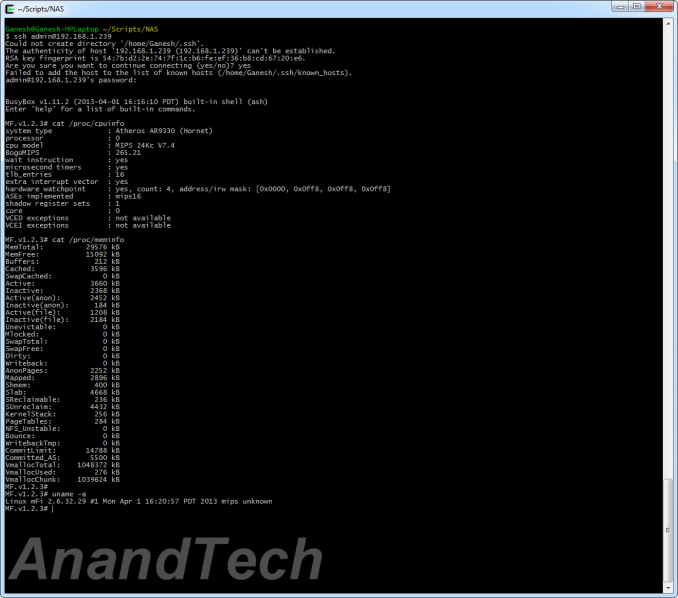Ubiquiti Networks mFi mPower Wi-Fi Power Strip Review
by Ganesh T S on November 21, 2013 3:00 AM EST- Posted in
- Home Automation
- Wi-Fi
- Ubiquiti Networks
- IoT
Inside the mPower
The mPower can be accessed and controlled via SSH even without linking it with a mFi host. In this case, the SSH login credentials are the default (ubnt/ubnt). The mPower unit runs Linux under its hood, with BusyBox providing much of the needed access functionality. The unit uses the Dropbear SSH server service. Accessing the unit over SSH gives us some insight into the core platform.
The mPower uses the Atheros AR9330 Hornet platform (more commonly found in wireless access points / low end routers such as this one) for its networking functionality and host CPU. The unit has 16 MB of RAM. The more interesting aspect is the chip used for collecting the electrical parameters. Ubiquiti takes pride in the fact that the electrical statistics are gathered by utility-grade ICs rather than the ADCs employed by other competing solutions. The mPower uses the Prolific PL7223 for gathering the electrical parameters. The PL7223 is apparently popular in these circles, as it also finds a place in GainSpan's SmartPlug kit. At this price point, it would be unfair to expect solid-state relays. So, we do have the clicking sounds when outlets are turned on or off.
FCC reports for all of Ubiquiti's products are linked on this page. We could have torn down the mPower unit ourselves, but, with the details of the platform evident from gaining SSH access, we leave it to the photographs provided in the FCC submission. They are reproduced in the gallery below.
In the next section, we will look into taking advantage of SSH for the development of custom applications.

















61 Comments
View All Comments
easp - Thursday, November 21, 2013 - link
I'm intrigued by it for controlling some relatively dumb devices that draw a lot of power, like space heaters, a dehumidifier and a floor-standing AC unit. With this, a cheap wireless weather and temp/humidity system I've already hacked, and a few scripts, I could easily start controlling things based on things like presence, differences between indoor and outdoor temps, etc.That obviously isn't something your average person is going to do, but it isn't hard to imagine that sort of thing becoming turn-key.
bznotins - Thursday, November 21, 2013 - link
When my home server (which I use as my personal cloud) hard-locks when I'm on the road, it would be nice to power-cycle it remotely. This will let me do that, so I ordered it.Sample size of one, but there are people that can use this kind of device.
jason32 - Friday, November 22, 2013 - link
Why is your server crashing like that and often enough for you to consider getting the mPower? You should probably fix that first before looking into the last resort power cycling solution.bznotins - Wednesday, November 27, 2013 - link
It only does it about once a month. Pretty hard to diagnose.But that once a month always seems to be when I'm on the road and can't power-cycle it in-person?
Is this power strip a panacea? No. But my point is that there is a use for it.
azazel1024 - Thursday, November 21, 2013 - link
I feel like an important piece of information is missing. How much does the mFi mPower ITSELF user in terms of power. It sounds interesting and I certainly have tons of ideas on how I could use it (or other could). However, a large part of that would be power savings.If the thing burns 5w of power though...that just might tip it from possibly saving power in some usage scenarios to burning more power than it saves.
ganeshts - Sunday, November 24, 2013 - link
I will update the article shortly.. It consumes slightly less than 1W when idle.samsp99 - Thursday, November 21, 2013 - link
Last weekend I found a similar product from quirky at home depot. In conjunction with GE they have a line of wifi connected products, including a sensor, egg monitor, guage dashboard, and a power strip with two outlets that can be remotely switched from an iOS or Android device.The cool thing is to program them you "blink" them by holding a smartphone screen against a sensor that detects a flashing sequence on the screen. This is based on tech from Electric Imp which developed the chipset and has a developer kit and SDK for building your own devices.
I bought the power strip for fun, but with an eye to controlling the xmas lights, so I can have them on a timer, but also switch on and off on demand.
Kurge - Thursday, November 21, 2013 - link
Might be moderately interesting if it support Vera. Would be even more interesting if it was a standard power outlet that fits in a normal box.As it stands - meh.
drizzo4shizzo - Thursday, November 21, 2013 - link
Don't plug your wifi router into it...nekoken - Thursday, November 21, 2013 - link
According to your screenshot this device has 32MB of ram, not 16.I may have to buy one or more of these. This looks like a good way to kick my children off of specific electronic devices remotely. ssh in and BAM!